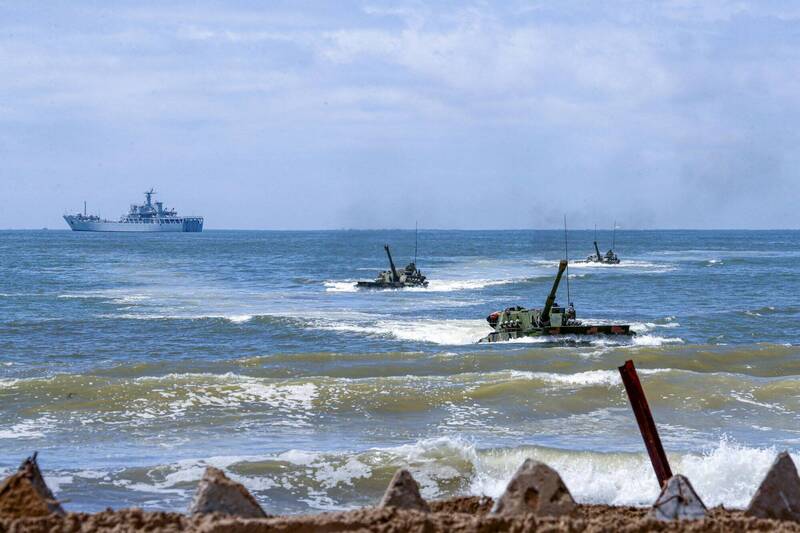The CSIS push assumes that China has a high level of amphibious capability.
(Reuters)
[Instant News/Comprehensive Report] On the 9th, the Center for Strategic and International Studies (CSIS), a think tank in Washington DC, announced the results of the latest Taiwan Strait conflict wargame. will end in failure.
In this report, CSIS listed the various settings that were set before the war game. Some war game experts put forward arguments, saying that the enemy must be expected to be lenient. Underestimating the PLA in conflict wargames.
Since China, the United States, and Taiwan are the main participating countries in the Taiwan Strait conflict, CSIS basically assumes that the personnel quality of the US, Chinese and Taiwan forces are of the same level in terms of the quality of personnel training before launching the military push.
The report pointed out that when the United States and potential enemies (including China) clashed in the past, the combat power setting tended to favor the United States because the training standards of the United States were higher than most countries.
In China, there are more unproven capabilities than in the United States.
Please read on...
According to the Bingtweet report, Chris Dougherty, a wargame expert at the Center for a New American Security (CNAS), put forward an argument that he should not underestimate the PLA in Taiwan Strait conflict wargames just because he overestimated the combat power of the Russian military in the past. combat power.
Dorty said that China's military modernization reform in the past 20 years, coupled with the anti-corruption policy led by Chinese President Xi Jinping, has built a professional army, and the scale of advanced weapons made in China far exceeds that of Russia. It will continue to improve during the year, especially since they have the ability to make the scale of military exercises bigger and bigger.
The CSIS military push assumes that China has a high level of amphibious capability, but in order for the PLA to have a high level of amphibious capability, it must increase the scale and intensity of landing exercises from now until 2026, evaluate and integrate military exercise experience, and then formulate combat plans.
For the Taiwan military training part, Bingtui basically assumes that the combat efficiency of Taiwan's military units is the same as that of Chinese units of similar size and equipment.
Regarding the training quality of Taiwan's military, experts have heatedly discussed it. Some experts believe that Taiwan's training methods are too rigid and lack imagination.
The other side of the argument points to the fact that Taiwanese would defend their homeland in the event of a conflict across the Taiwan Strait, possibly demonstrating the courage and tenacity that Ukrainians displayed in resisting Russian aggression.
But despite high morale, lack of training and high-end equipment will keep Taiwan's reserve forces at half strength in basic settings.
In the comparison of combat power between the PLA Air Force and the U.S. Air Force, the think tank basically assumes that the United States and China have the same capabilities in "every generation of fighter jets." And Air Force generals have warned that the U.S. advantage is waning, with the U.S. Air Force’s experience in large-scale air combat and stealth fighters being offset by the range of China’s air-to-air missiles and geographical advantages in the Taiwan Strait conflict.
The advantage of the United States lies in the culture of the Air Force, job mobility, and the pilot training programs of the "Red Flag Military Exercise" and the "U.S. Navy Fighter Weapons School".
Although China is still inferior to the United States in these aspects, China's "Thunderbolt-15" (PL-15) air-to-air missile has a range that exceeds the Advanced Medium-Range Air-to-Air Missile (AMRAAM) used by most countries' air forces, which means that China can Gain an advantage in combat beyond visual range.
In addition, the Taiwan Strait conflict combat area is relatively close to China, and U.S. military pilots must fly from Japan to the Taiwan Strait combat area. The physical exertion of PLA pilots in Taiwan Strait air combat will be lower than that of American pilots.
In addition, the PLA's surface-to-air missiles can also provide protection for the PLA Air Force in combat.
In terms of comparison of the fifth-generation fighter jets, the United States has been using stealth military aircraft for a longer period of time, and the design of the fifth-generation fighter jets is also more mature. Compared with the U.S. stealth fighter jets, the outside world knows much less about the Chinese J-20.
Most analysts believe that compared with the F-22 and F-35, the J-20 has a larger radar cross-sectional area, which means that its stealth performance is worse, and the J-20 is unlikely to be equipped with the same combat capabilities as the F-35. combat system.
In terms of comparison of fifth-generation fighters, the United States has been using stealth military aircraft for a longer period of time, and the design of fifth-generation fighters is also more mature.
The picture shows the People's Liberation Army J-20 fighter jet.
(Reuters)
